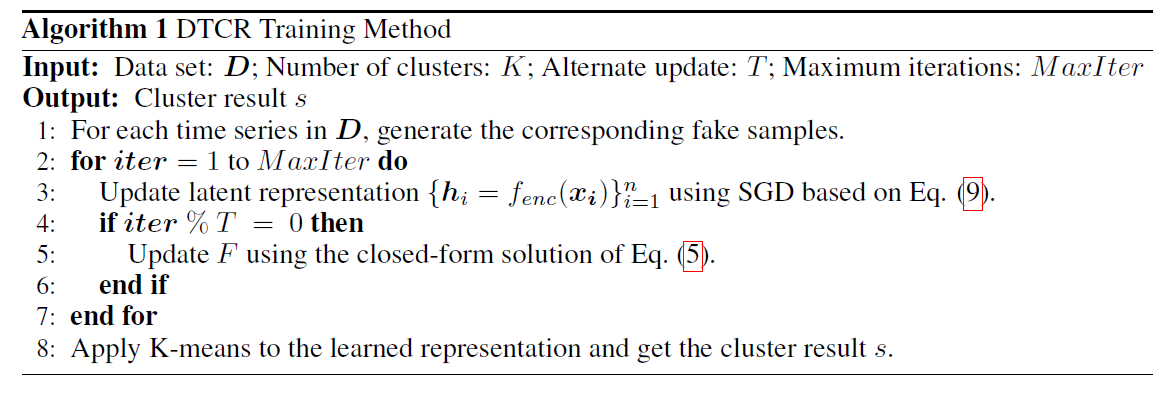Learning Representations for Time Series Clustering (2019)
Contents
- Abstract
- Introduction
- Related Works
- raw-data-based methods
- feature-based methods
- DTCR (Deep Temporal Clustering Representation)
- Deep Temporal Representation Clustering
- Encoder Classification task
- Overall Loss Function
- Pseudo-code
0. Abstract
TS clustering : essential, when category information is not available
propose a novel unsupervised temporal representation learning model, called..
- DTCR (Deep Temporal Clustering Representation)
DTCR
- integrates “(1) temporal reconstruction” & “(2) K-means objective” into seq2seq
- obtain cluster-specific temporal representations
1. Introduction
Feature-based methods
- extracted features & clusters
- robust to noise & filter out irrelevant information
- reduce data dimension & improve efficiency
- BUT, most are domain-dependent
Deep Learning models
-
seq2seq
- learn general representations from sequence data in unsupervised manner
-
[THIS PAPER]
-
aim to learn a non-linear temporal representation for time-series clustering, using seq2seq
-
relies on the capabilities of encoder
-
Propose DTCR (Deep Temporal Clustering Representation)
- 1) generate CLUSTER-SPECIFIC temporal representations
- 2) integrates “(1) temporal reconstruction” & “(2) K-means objective” into seq2seq
- 3) adapts bidirectional Dilated RNN as encoder
2. Related Works
time series clustering
- 1) raw-data-based methods
- 2) feature-based methods
(1) raw-data-based methods
-
mainly modify distance function
-
ex) k-DBA ( = K-means + DTW )
-
ex) k-SC ( K-Spectral Centroid )
- uncover the temporal dynamics, using similarity metric that is invariant to scaling/shifting
-
ex) k-Shape
- considers the shapes of time series
- using a normalized version of cross-correlation measure
-
above are sensitive to outliers & noise
( \(\because\) all time points are taken into account )
(2) feature-based methods
- 1) mitigates the impact of noise / outliers
- 2) reduce dimensionality
- divide feature-based methods into
- (1) two-stage approaches : extract features \(\rightarrow\) clustering
- (2) jointly optimize
DTC (Deep Temporal Clustering)
- use “auto encoder” & “clustering layer”
- learn non-linear cluster representation
- clustering layer : designed by measuring KL-divergence between predicted & target distn
3. DTCR (Deep Temporal Clustering Representation)

Summary
-
(1) [ENCODER] raw time series \(\rightarrow\) latent space of representation
-
(2) [DECODER] representations \(\rightarrow\) reconstruct input
( + K-means objective is integrated….to guide representation learning )
-
propose fake-sample generation & auxiliary classification task to enhance encoder
(1) Deep Temporal Representation Clustering
Notation
- \(n\) : number of time series ( \(n>1\) : MTS )
- \(D=\left\{x_{1}, x_{2}, \ldots, x_{n}\right\}\).
- each time series \(x_{i}\) : contains \(T\) ordered real values
- \(\boldsymbol{x}_{\boldsymbol{i}}=\left(x_{i, 1}, x_{i, 2}, \ldots x_{i, T}\right)\).
- encoder & decoder
- \(f_{\text {enc }}: \boldsymbol{x}_{\boldsymbol{i}} \rightarrow \boldsymbol{h}_{\boldsymbol{i}}\).
- \(f_{\text {dec }}: h_{i} \rightarrow \hat{x}_{i}\).
- \(m\)-dim latent representation : \(h_{i} \in \mathbb{R}^{m}\).
- \(h_{i}=f_{\text {enc }}\left(x_{i}\right)\).
- decoded output :
- \(\hat{\boldsymbol{x}}_{\boldsymbol{i}}=f_{\text {dec }}\left(\boldsymbol{h}_{\boldsymbol{i}}\right)\).
Reconstruction Loss : MSE
-
\(\mathcal{L}_{\text {reconstruction }}=\frac{1}{n} \sum_{i=1}^{n} \mid \mid \boldsymbol{x}_{\boldsymbol{i}}-\hat{\boldsymbol{x}_{\boldsymbol{i}}} \mid \mid _{2}^{2}\).
-
not sufficient!
( not suitable for clustering task )
K-means Objective
- \(\mathcal{L}_{K-\text { means }}=\operatorname{Tr}\left(\boldsymbol{H}^{\boldsymbol{T}} \boldsymbol{H}\right)-\operatorname{Tr}\left(\boldsymbol{F}^{\boldsymbol{T}} \boldsymbol{H}^{\boldsymbol{T}} \boldsymbol{H} \boldsymbol{F}\right)\).
- minimization of \(\mathrm{K}\)-means = trace maximization problem associated with the Gram matrix \(\boldsymbol{H}^{T} \boldsymbol{H}\)
- static data matrix \(\boldsymbol{H} \in \mathbb{R}^{m \times N}\)
- \(\boldsymbol{F} \in \mathbb{R}^{N \times k}\) is the cluster indicator matrix.
- use as regularization term
Final Objective
\(\min _{\boldsymbol{H}, \boldsymbol{F}} J(\boldsymbol{H})+\frac{\lambda}{2}\left[\operatorname{Tr}\left(\boldsymbol{H}^{\boldsymbol{T}} \boldsymbol{H}\right)-\operatorname{Tr}\left(\boldsymbol{F}^{\boldsymbol{T}} \boldsymbol{H}^{\boldsymbol{T}} \boldsymbol{H} \boldsymbol{F}\right)\right], \text { s.t. } \boldsymbol{F}^{\boldsymbol{T}} \boldsymbol{F}=\boldsymbol{I}\).
- \(J(\boldsymbol{H})\) : 1) + 2)
- 1) reconstruction loss
- 2) classification loss
(2) Encoder Classification task
better encoder = better representation
\(\rightarrow\) propose a fake-sample generation strategy & auxiliary classification task
fake-sample generation
-
generate its fake version by randomly shuffling some time steps
-
number of selected time steps = \(\lfloor\alpha \times T\rfloor\)
( where \(\alpha \in(0,1]\) is a hyper-parameter we set to \(0.2\) )
auxiliary classification task
-
train the encoder to detect whether a given time series is REAL or FAKE
-
trained by minimizing …
\(\mathcal{L}_{\text {classification }}=-\frac{1}{2 N} \sum_{i=1}^{2 N} \sum_{j=1}^{2} 1\left\{y_{i, j}=1\right\} \log \frac{\exp \hat{y}_{i, j}}{\sum_{j=1}^{2} \exp \left(\hat{y}_{i, j}\right)}\).
where \(\hat{y}_{i}=W_{f c 2}\left(\boldsymbol{W}_{f c 1} h_{i}\right)\).
- \(y_{i}\) : 2-dim one-hot vector ( = answer )
- \(\hat{y}_{i}\) : classification result
- \(\boldsymbol{W}_{f c 1} \in \mathbb{R}^{m \times d}, \boldsymbol{W}_{f c 2} \in \mathbb{R}^{d \times 2}\).
(3) Overall Loss Function
\(\mathcal{L}_{D T C R}=\mathcal{L}_{\text {reconstruction }}+\mathcal{L}_{\text {classification }}+\lambda \mathcal{L}_{K-\text { means }}\).
(4) Pseudo-code

